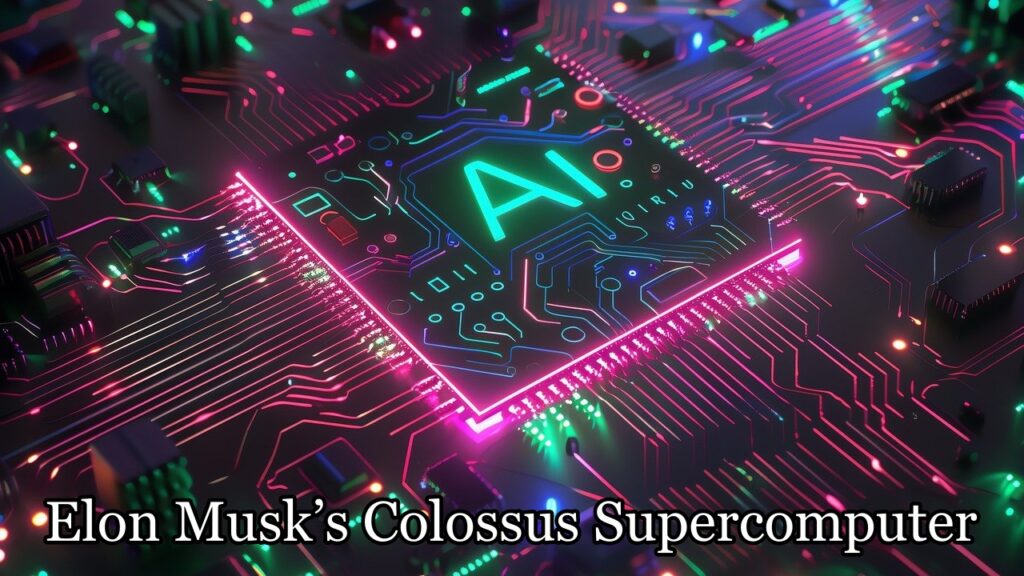In an unprecedented leap forward in artificial intelligence, Elon Musk and his XAI startup have created the largest and most powerful AI training supercomputer in the world. Named Colossus, this technological powerhouse is designed to revolutionize AI and tackle some of the universe’s most profound mysteries.
Colossus is built with cutting-edge hardware and energy solutions, including Nvidia GPU technology, liquid cooling systems, and massive Tesla MEAP batteries. Musk believes this extraordinary system will lay the foundation for the world’s most advanced AI, which will continue to evolve and solve complex challenges for years to come. Here’s a deep dive into what makes Colossus truly remarkable.
Location and Design of Colossus
Located in Memphis, Tennessee, in an industrial park southwest of the city center, Colossus occupies the building that was previously home to Electrx, a Swedish appliance manufacturer. The choice of Memphis is strategic, as Musk’s team was able to find the ideal space to rapidly build and launch the supercomputer. While the exterior of Colossus may appear unassuming, the real magic happens inside.
Inside Colossus: The Powerhouse of AI
Inside, Colossus boasts the largest AI training cluster in the world. With over 100,000 Nvidia HGX H100 GPUs, it is connected to exabytes of data storage and an ultra-fast network infrastructure.
According to Nvidia CEO Jensen Huang, Colossus is “easily the fastest supercomputer on the planet.” This immense power will fuel the development of Gro, an AI model that Musk and XAI aim to evolve into something far beyond a simple chatbot—ultimately a step toward artificial super intelligence.
Building Colossus in Record Time
Incredibly, Colossus was constructed in just 122 days, a feat that’s unheard of in traditional supercomputing. For comparison, other supercomputer clusters typically have half to one-quarter of the GPU capacity of Colossus, and their construction can take several years. The data hall inside Colossus uses a unique raised-floor configuration, optimizing power, cooling, and GPU performance in a streamlined, highly efficient manner.
Efficient Cooling and Power Systems
One of the most innovative aspects of Colossus is its liquid cooling system. Below the GPU clusters, a network of massive pipes transports water through the facility. Hot water from the servers is sent out to a chiller, cooling the water before it returns to absorb more heat. This cutting-edge cooling system prevents overheating while ensuring optimal performance.
The Tesla MEAP battery system plays an essential role in powering the entire operation. Because even slight power fluctuations can disrupt AI training, the MEAP batteries ensure a consistent and reliable power supply. This unique energy solution is especially critical as XAI plans to double Colossus’s size to 200,000 GPUs in the near future.
GPU Racks: Efficiency in Design
Each of Colossus’s GPU racks is built to maximize efficiency. Every rack contains eight Nvidia H100 GPUs, the most advanced chips for AI training, along with 16 CPU chips. The GPU racks are equipped with independent water cooling systems, enabling fast maintenance without the need to shut down the entire system. This serviceable design reduces downtime and ensures maximum uptime for AI training.
Cutting-Edge Data Network
Colossus utilizes a super-fast ethernet network powered by Nvidia Bluefield 3 DPUs (Data Processing Units). These chips can handle 400 Gbps, a speed 400 times faster than typical home internet connections. With this network, Colossus can efficiently store and access vast amounts of data—up to exabytes—necessary for training the AI model.
Colossus: The AI Evolution
This cutting-edge supercomputer is not just about brute power; it’s about accelerating AI’s evolution. Currently, Colossus is dedicated to training Gro, an AI chatbot developed by XAI. Recently, Gro received a significant upgrade, enabling it to analyze images in addition to text, making it even more powerful and versatile. This new vision capability is integrated with the X social media platform, allowing users to interact with Gro by sending images for analysis.
The end goal for Gro is to become an Artificial General Intelligence (AGI)—an AI that can perform any task, mimicking the human mind’s incredible versatility. AGI would have the potential to unlock the mysteries of the universe and solve complex, previously unsolvable problems.
The Future of XAI and Colossus
The rapid evolution of Colossus and its AI model is making waves in the tech world. OpenAI CEO Sam Altman has expressed concern that Musk’s XAI might soon surpass their own capabilities in AI training power. XAI raised $6 billion in venture capital to fund its operations, which helped push the company’s valuation to $24 billion in just one year. Musk is now reportedly seeking even more funding to boost XAI’s valuation to $40 billion—a bold move that could position the company as a serious competitor in the AI race.
Conclusion: A Glimpse into the Future
Colossus represents not just the future of AI, but also a monumental leap in computing and energy efficiency. With its unparalleled GPU power, liquid cooling, and Tesla-backed energy systems, Colossus is primed to push the boundaries of what artificial intelligence can achieve. As Gro and other AI models continue to evolve, the world may soon witness the birth of an Artificial Super Intelligence capable of reshaping humanity’s future.
Read More:

